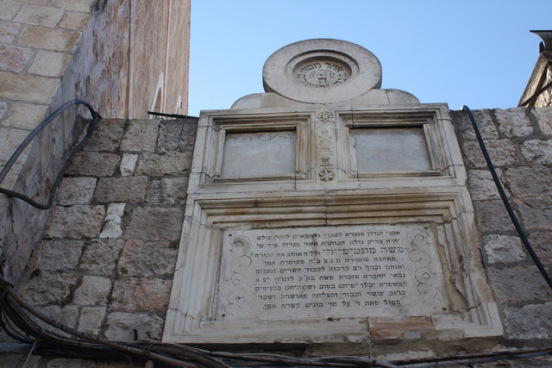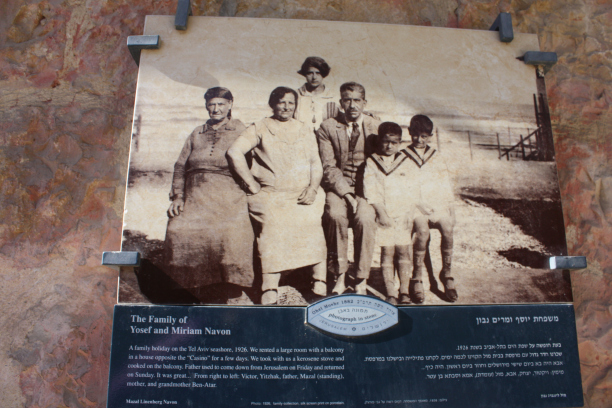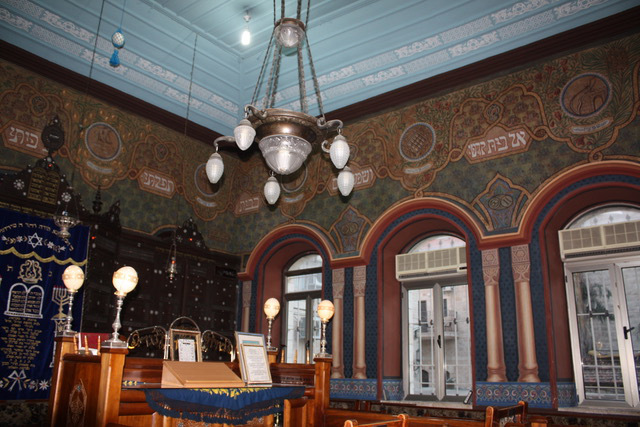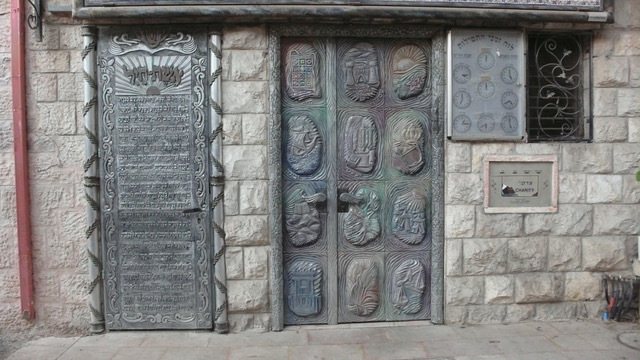
At one point there were 300 synagogues in Nahlaot, a community built outside the walls of Jerusalem in the late 19th century. Kurds, Greeks Persians and North Africans were among Nachlaot’s residents. Ruth Corman took a guided tour:
One of the most fascinating areas in Jerusalem is Nachlaot close to Mahane Yehuda Market. Its winding lanes and alleyways reveal a variety of architecture, hidden courtyards, artists’ studios and a proliferation of synagogues.
The original residents arrived in the late 1870’s to escape the overcrowded and unhealthy living conditions in the Old City. The first community built was there was Mishkenot Yisrael. Sir Moses Montefiore, the British Jewish philanthropist, established the first community outside the Old City walls at Mishkenot Sha’ananim. He then created two Nachlaot communities, Mazkeret Moshe, for Ashkenazim followed by Ohel Moshe for Sephardim in 1882. Three others were also named in his honour. In 1900 Jews from Syria arrived and 1925 the Yemenites established Nachalat Achim. Nachlaot ultimately comprised 23 groups including Kurds, Greeks, Persians, Italians, Armenians, North Africans plus Ashkenazim from various countries.

Dedication to Sir Moses Montefiore at the entrance of Ohel Moshe.
Walking through the narrow cobbled streets one can readily bring to life the rich tapestry of cultures living together harmoniously from the photographs and texts mounted on the house walls telling of the families that once lived there.
Daniel Senior’s family were expelled from Spain in 1492, fled to Turkey and eventually came to Jerusalem. He lived in the Old City, running a vegetable shop in partnership with an Arab. As one of the first to move to Ohel Moshe, then surrounded by fields, he was regarded as the Mukhtar (Head of the Village). His home comprised one room, on top of which he built a second and then a third – the ground floor eventually becoming a store.
Rabbi Binyamin Halevy’s family fled from Spain to Livorno Italy where they remained for 240 years, coming to Jerusalem in 1732. Halevy’s descendants became scholars, rabbis and community leaders. One was Chief Rabbi. It was he who supervised the re-building of a water and sewage system for Nachlaot damaged by earthquake. He made a huge contribution to Jewish life and was an ardent Zionist. Another was an emissary who, in 1882, travelled to India to investigate the Black Jews of Cochin whose history dates back to the 12th century. He returned declaring that they should be allowed to convert to Judaism although it took until 1950 for the majority of them to reach Israel. Halevy’s descendants are ninth generations Israelis.
Others commemorated in the plaques are Rabbi Shalom Hadaya, who chose to live there because “They speak Ladino, which I do not understand, so I will not be able to hear slander” (Lashon hara), and Avraham Cohen – the Dairyman for Nachlaot – whose family have now lived in Israel for ten generations.

Photo and text of Navon’s family.
The first Sephardi Israeli president, Yitzchak Navon, was born in Ohel Moshe in 1921, descended from Spanish Jews who settled in Turkey after fleeing Spain. They moved to Jerusalem in 1670. As well as being a diplomat and academic, Navon was an accomplished author and reminiscences of his childhood in Ohel Moshe provided the inspiration for his play Bustan Sephardi ( Sephardi Orchard) in 1970.
Written in Ladino, (a Spanish based language spoken by Sephardi Jews) it is the longest running play to appear at Habima Theatre where it ran for 28 years. It celebrates, through stories and songs, the vibrant life of Ohel Moshe in the 1930’s.
At one time there were 300 synagogues in Nachlaot, probably the largest number to be built anywhere in the world in such close proximity. Some were simply a room to accommodate the 10 men required for communal prayers. Today there remain around 100 offering a choice of prayer services to suit all tastes.

Interior of Ades Synagogue
Jews from Aleppo built the Ades synagogue, renowned for its unique liturgical style and baquashot (pleas) – a cycle of Cabalistic poetry sung at 3am Shabbat mornings during the winter months. Apparently it plays to full houses and for one brief moment I considered going to the service, but common sense prevailed, added to the fact that I have never been known to rise before 9am. Instead I visited the synagogue at a respectable hour, found the door open and was permitted to enter and take photographs. The interior is exquisite – the Ark occupies the entire eastern wall and is made of carved walnut inlaid with mother of pearl. It was brought from Damascus over 100 years ago. A mural adorns another wall, created by one of founders of the the Bezalel Art School.
 Ark of the Ades Synagogue
Ark of the Ades SynagogueThe Or Zarua synagogue (1926), in Spanish North African style, is now a historic preservation site, and nearby is the Chessed Ve Rachamim ( Kindness and Mercy) Sephardi synagogue, with its richly decorated interior and depictions of the Twelve Tribes and the Eshet Chayil (Woman of Valour) poem on its frontage. The building is eclectic, resembling something from Grimm’s fairy tales, but it was still surprising to discover that it had once been a pub. Not something that one normally expects to find in Jerusalem, akin to the fish and chip shop that I discovered in Mahane Yehuda.

Front of Chessed ve Rachamim Synagogue
90 years ago a local butcher, Isaac Emosa, persuaded the pub owner to vacate the premises immediately with an offer of £10 sterling. One of Emosa’s descendants, Cantor Mori Emosa leads the services today – it is said that his ‘utterly precise cantillation’ is operatic aria.(quote:Jacob Solomon)
After WW1 6,000 people lived in Nachlaot. New immigrants arrived in the 1920’s but many preferred the newer neighbourhoods and Nachlaot became home to those who rented properties – the area became neglected. Following the establishment of the State of Israel (1948), more arrived, including Jews who had been thrown out of the Jewish Quarter of the Old City by the Jordanians and Jews fleeing from North African countries.

Leave a Reply